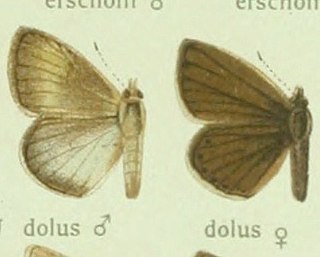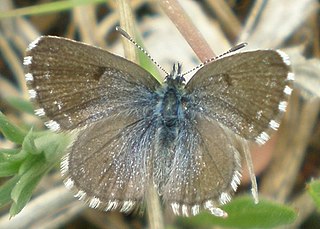
The chalkhill blue is a butterfly in the family Lycaenidae. It is a small butterfly that can be found throughout the Palearctic realm, where it occurs primarily in grasslands rich in chalk. Males have a pale blue colour, while females are dark brown. Both have chequered fringes around their wings.

Friedrich Joseph Adalbert Seitz, was a German physician and entomologist who specialised in Lepidoptera. He was a director of the Frankfurt zoo from 1893 to 1908 and is best known for editing the multivolume reference on the butterflies and larger moths of the world Die Gross-Schmetterlinge der Erde which continued after his death.

Kretania hesperica, the Spanish zephyr blue, is a species of butterfly in the family Lycaenidae. It is endemic to Spain. Its natural habitats are temperate shrubland and temperate grassland. It is threatened by habitat loss.Seitz describes it thus - hesperica Rbr. is above sky-blue instead of violet-blue; from Spain.

Lysandra is a genus of butterflies in the family Lycaenidae.

Melitaea aurelia, or Nickerl's fritillary, is a butterfly of the family Nymphalidae. It is found in central Europe.

Melitaea phoebe, the knapweed fritillary, is a butterfly of the family Nymphalidae. It is found in the Palearctic realm, except the northernmost locations. It used to include Melitaea telona, recently revalidated as a distinct cryptic species.

Lysandra albicans, the Spanish chalk-hill blue, is a butterfly of the family Lycaenidae. It is found in Spain and Western North Africa.

Lysandra hispana, the Provence chalk-hill blue, is a butterfly of the family Lycaenidae. It is found in Spain, southern France and northern Italy.

Boloria thore, the Thor's fritillary, is a butterfly of the family Nymphalidae. It occurs in damp places in the Alps, Fennoscandia, the south of European Russia, the Urals and east across the Palearctic to Siberia and Japan.

Coenonympha gardetta, the Alpine heath, is a butterfly species belonging to the family Nymphalidae. It can be in alpine meadows on heights of 800 to 2,900 from the Massif Central to Albania.

Polyommatus dolus, the furry blue, is a butterfly of the family Lycaenidae. It is found in Spain, in France and Italy.

Ripart's anomalous blue is a butterfly in the family Lycaenidae.

Hipparchia syriaca is a species of butterfly in the family Nymphalidae. It is found in Greece especially on the island of Samos, Turkey, Bulgaria, Albania, North Macedonia, Caucasus and Transcaucasia. It is found on the edges of foothills and mountain forests up to 2,000 m

Polyommatus (Plebicula) dorylas, the turquoise blue, is a butterfly of the family Lycaenidae. It is found in southern Europe, Asia Minor, the Ural Mountains, Caucasus and Transcaucasia. Its wingspan is 15–17 mm. The butterfly's common name comes from the dazzling bright blue colour of male's wings. The larvae feed on Anthyllis vulneraria. The butterfly flies from May to September in two generations. Habitats include flowery meadows in rocky areas at 500–2000 m.

Hyponephele lupina, the Oriental meadow brown or branded meadowbrown, is a butterfly of the family Nymphalidae. It is found in North Africa, south western Europe, southern Russia, Asia Minor, southern Siberia, Middle Asia, Iran and from Baluchistan to Nepal.Seitz describes it thus- lupinus Costa is rather considerably larger than the forms [of Epinepele] so far named; the rusty yellow on the underside of the forewing is brighter, the underside of the hindwing strongly speckled. Southern Italy, Greece.

Plettenberg is a mountain of Baden-Württemberg, Germany. It is located in Zollernalbkreis.

Pseudophilotes panoptes, the Panoptes blue, is a butterfly of the family Lycaenidae. It is found on the Iberian Peninsula and in North Africa, including Morocco.

Polyommatus nivescens, the mother-of-pearl blue, is a species of butterfly in the family Lycaenidae. It is found in Spain. It is a small butterfly with a sexual dimorphism. The upperside of the male is very clear, with just a bluish beige reflection bordered by a thin grey line and a marginal line of small grey dots. The female upperside is brown, decorated with a marginal line of large orange maculae bordering the hindwings and part of the forewings. Both have a white fringe. The underside is light ochre marked with a marginal line of white lunules topped with orange, and adorned with a line of black dots circled in white very marked on the fore.

Lysandra corydonius, the false chalkhill blue, is a butterfly of the family Lycaenidae. The species is distributed in south-eastern Europe, Caucasus, Transcaucasia, north-eastern Turkey, and north-western Iran. L.corydonius is very similar to Lysandra coridon but a slight violet sheen is present, especiallv in the outer area of the wings. .It inhabits a wide variety of grasslands and woodlands. In Armenia it occurs from 1200 to 2000 m above sea level. The known larval host plants of the species in Turkey is Hippocrepis comosa, in the Caucasus - Coronilla varia. The species has not been assessed for the IUCN Red List. In Armenia from 2003 to 2013 its population increased.


















